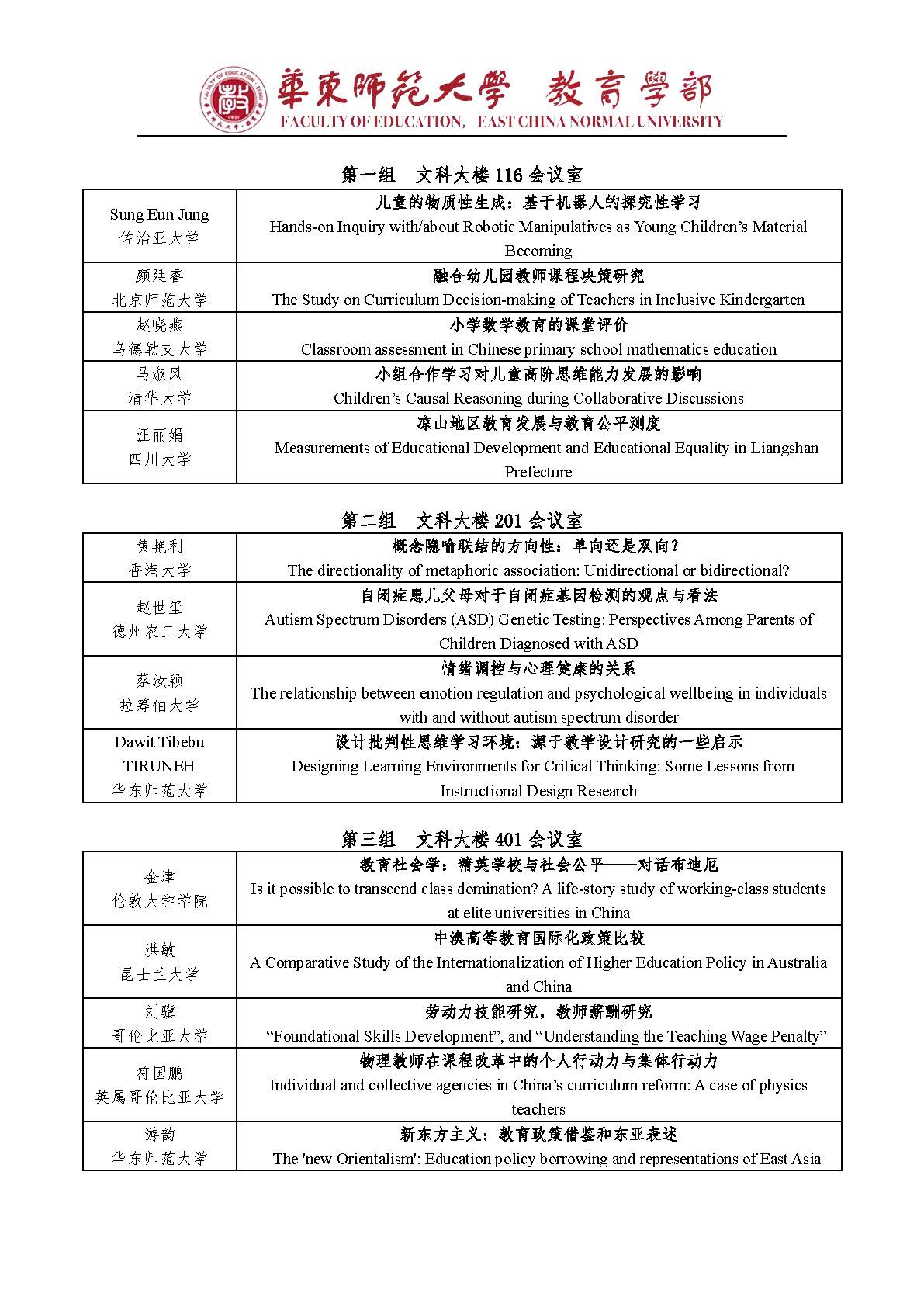华东师范大学2018年青年学者国际论坛
教育学分论坛暨高峰博士后学术研讨会
议 程
领导致辞和主题报告(图书馆二楼报告厅)
9:00-9:30 学部领导致辞
9:30-10:15 如何运用国际公共数据库研究前沿教育和心理学课题
How to use public international databases to explore leading-edge topics in education and psychology
郭捷思 博士后研究员,教育积极心理学研究所,公共卫生学院,澳大利亚天主教大学
10:15-11:00 高等教育理念的逻辑整合
Logical Integration of Ideas in Higher Education
A.Y.M. Atiquil Islam 博士后研究员,教育学部,华东师范大学
11:00-11:30 人才引进咨询会
午餐休息
11:30-13:30 秋林阁三楼
分组研讨会
报告摘要:
Hands-on Inquiry with/about Robotic Manipulatives as Young Children’s Material Becoming
Sung-eun Jung
The logic of learning abstract ideas through tangible and interactive robotic manipulatives is often echoed to advocate robotics education for young children. Considering that hands-on experience is an essential principle of teaching and learning, robotics manipulatives can be a good fit for young children’s needs. In this study, inspired by Bakhtin’s (1982) dialogism and new materialist perspectives (Barad, 2007; Bennett, 2010; Taguchi, 2010), I aim to explore the nature of 5 to 6-year-old children’s hands-on inquiry with/about robotics manipulatives. As a qualitative case study, I collected about 11 hours of video-recorded data of his inquiry about robotic manipulatives while the children participated in a robotics education program at an informal community learning center in Georgia of the United State. In my analysis, I traced children’s ongoing inquiry about/with robotics manipulatives and identified their material practices involved in the inquiry: encounter, emergence, evolvement, embodied expression, and entanglement. By presenting visual data (e.g., video clips, photos, illustrations), I examined how the robotic manipulatives and other materials were the agentive source of children’s inquiry. Also, I argued that children’s interdependency with materials did not limit their agency but rather exercised and expended their agency during the inquiry. I discussed how young children’s interrelationship with robotics manipulatives and materials should be appreciated as a vital state/mode of learning. Also, I discussed how the materiality of new robotics technology has potential for early childhood education practices beyond serving only as a medium of STEM.
融合幼儿园教师课程决策研究
颜廷睿
学前融合教育已经成为特殊幼儿接受早期教育的重要形式。由于学前教育领域课程权力的下放和园本课程的开发,幼儿教师的课程决策成为融合幼儿园促进特殊幼儿课程学习与课堂参与的关键。基于这一现实,本研究采用质的研究范式中的个案研究策略,旨在通过对融合幼儿园教师课程决策的过程及其影响因素研究,探究融合幼儿园幼儿教师课程决策的特征。在研究结果中,在总结融合幼儿园教师课程决策的五个要素、四种教师课程决策的方式以及课程决策影响因素的基础上,认为融合幼儿园教师课程决策呈现四个方面的特征:(1)融合幼儿园教师的课程决策是一个在科学取向与经验取向支配下相互博弈的冲突过程;(2)幼儿教师在课程决策中面临着兼顾普通幼儿与特殊幼儿课程学习需要的均衡抉择;(3)幼儿教师的课程决策以尊重特殊幼儿差异与促进他们的课程参与为目标;(4)幼儿教师的课程决策是在特定情境中与不同群体的互动生成的。
Classroom assessment in Chinese primary school mathematics education
赵晓燕
In mainland China, where there exists a deeply-rooted examination culture, an assessment reform promoting the use of assessment to support teaching and learning has been carried out since 2001. After a decade, however, only a few studies have been done that focus on primary school mathematics teachers’ assessment practice at the classroom level. With this background, the Improving Classroom Assessment in China (ICA-C) project, as a sequel to the ICA project in the Netherlands, was set up, which contains four studies in total.
Classroom assessment, or formative assessment in the hands of teachers, is the assessment that teachers continuously do during teaching with the aim of collecting information about students’ learning and make adequate instructional decisions to meet students’ needs. To shed light on the current situation of Chinese primary school mathematics teachers’ perception and practice of classroom assessment, a review study was carried out based on 266 teacher-written papers addressing classroom assessment. Then, a large-scale questionnaire survey with 1101 teachers was conducted to identify different assessment profiles of teachers.
Hereafter, two studies were set up to explore the use of classroom assessment techniques (CATs) in Chinese primary school mathematics classrooms. CATs are short teacher-initiated targeted assessment activities proximate to the textbook, which teachers can use in their daily practice to make informed instructional decisions. In the third study, 6 third-grade teachers were offered a series of CATs assessing students’ understanding of division; in the fourth study, 25 third-grade teachers were given eight CATs assessing students’ understanding of multiplication.
The most unexpected finding of the ICA-C project is that, although the Chinese primary school mathematics teachers generally endorsed the idea of conducting assessment for improving teaching, adapting further teaching based on the assessment information seems to be a missing piece in their picture and practice of classroom assessment.
Children’s Causal Reasoning during Collaborative Discussions
马淑风
This study aims to understand the construction of multilink causal reasoning chains during collaborative discussions in elementary school classrooms. The construction of reasoning chains was investigated in 24 collaborative discussions involving 160 underserved fifth-grade children. The effects of group features, individual characteristics, and moment-by-moment situational influences on seven causal chain models were tracked in the discussions. Results indicated that students who were more talkative, had better oral English, and were more liked by their classmates were more likely to produce causal chains. The turn-by-turn analysis of chain construction revealed that once a causal chain was initiated, it was likely to continue for at least three speaking turns. Leaders and socially centered students supported other group members, the shy and quiet students, to extend chains of reasoning. Agreement among group members and support from leaders and socially centered students extended the chain of reasoning. However, refutation and disagreement stopped the chain because the group had to resolve disputed ideas in order to develop a shared understanding. A temporal analysis of chain production indicated that chain construction speeds up over the course of a discussion. Students who produced more causal chains during the discussion also generated more causal chains in an individually written essay after the discussion. A causal analysis showed that peer dialogue mediates the effects of social and cognitive characteristics on chain production in the essay and the mediating effect increases with increases in the number of peer-generated causal chains during the discussions. Overall, this analysis of the social construction of multilink causal reasoning chains provides distinctive new evidence that enabling meaningful interaction among children promotes their higher-level cognitive development.
Measurements of Educational Development and Educational Equality in Liangshan Prefecture
汪丽娟
Liangshan Prefecture is pertaining to the poorest minority regions in China who has the obligation to get rid of poverty until 2020 as figured in the government’s plan. What extent the educational development in Liangshan has reached? What kind of problems are figuring in the process of democratization of educational opportunities aiming at educational equality? This paper constitutes an exploratory analysis of educational attainment by Han and minority students. Using data of enrolled students in primary and secondary school in 2000, 2007 and 2015 collected by the local authority, we intend to know more about their educational attainment by gauging the Average years of Schooling, Education Gini Coefficient and it’s decomposition by ethnicity and by rural-urban indicator.
These measurements allow us to ascertain several findings: first of all, the average years of schooling has prolonged to Han as to minorities from 2000 to 2015 with the boost of related policies, and the increment speed of Han is faster that of minorities’, but the gap with the average level of China still persists and gets larger in 2015 .
Secondly, the education gini coefficients suggest that the inequality on schooling access is increasing for both Han and minorities in Liangshan. With analysis on their decompositions, we find out that the contribution of intragroup to educational inequality is experiencing a high increment speed amongst minorities, while it’s reducing within Han. In parallel, the contribution of intergroup Han/minorities is increasing which means the gap between Han and minorities in schooling access is dampening.
Thirdly, we notice that rural minorities’ education Gini coefficient is rising and the decomposition suggests the importance of rural minorities’ intragroup contribution to educational inequality, while the urban minorities’ intragroup contribution and the rural-urban minorities’ inter-group contribution is reducing.
The directionality of metaphoric association: Unidirectional or bidirectional?
黄艳利
The conceptual metaphor theory (Lakoff & Johnson, 1980, 1999) postulates a unidirectional metaphoric association between abstract and concrete concepts: sensorimotor experience activated by concrete concepts facilitates the processing of abstract concepts, but not the other way around. However, this unidirectional view has been challenged by studies that reported a bidirectional metaphoric association. In three experiments, we tested the directionality of the brightness-valence metaphoric association, using Stroop-like paradigm, priming paradigm, and Stroop-like paradigm with a go/no-go manipulation. Both mean and vincentile analyses of reaction time data were performed. We showed that the directionality of brightness-valence metaphoric congruency effect could be modulated by the activation level of the brightness/valence information. Both brightness-to-valence and valence-to-brightness metaphoric congruency effects occurred in the priming paradigm, which could be attributed to the presentation of prime that pre-activated the brightness or valence information. However, in the Stroop-like paradigm the metaphoric congruency effect was only observed in the brightness-to-valence direction, but not in the valence-to-brightness direction. When the go/no-go manipulation was used to boost the activation of word meaning in the Stroop-like paradigm, the valence-to-brightness metaphoric congruency effect was observed. Vincentile analyses further revealed that valence-to-brightness metaphoric congruency effect approached significance in the Stroop-like paradigm when participants’ reaction times were slower (at around 490 ms). The implications of the current findings on the conceptual metaphor theory and embodied cognition are discussed.








